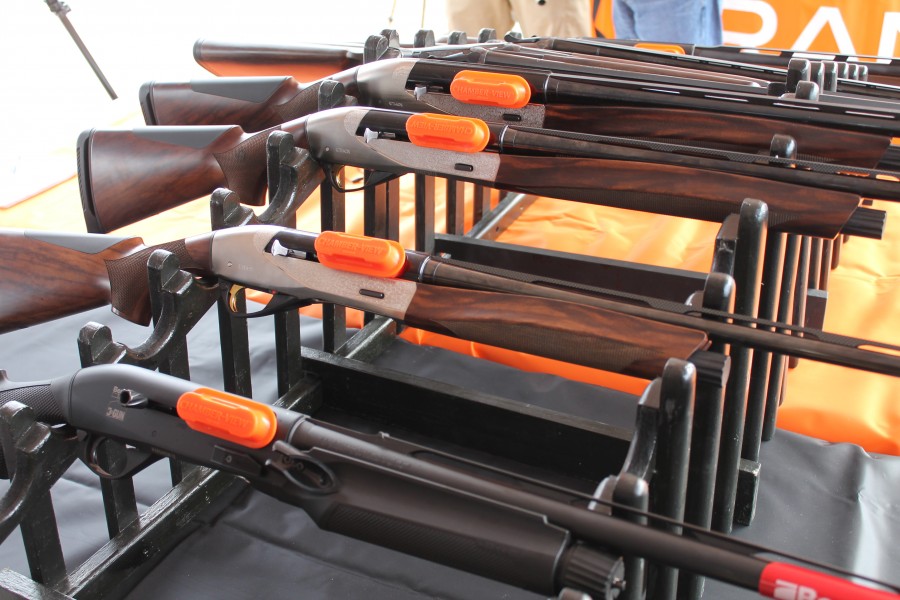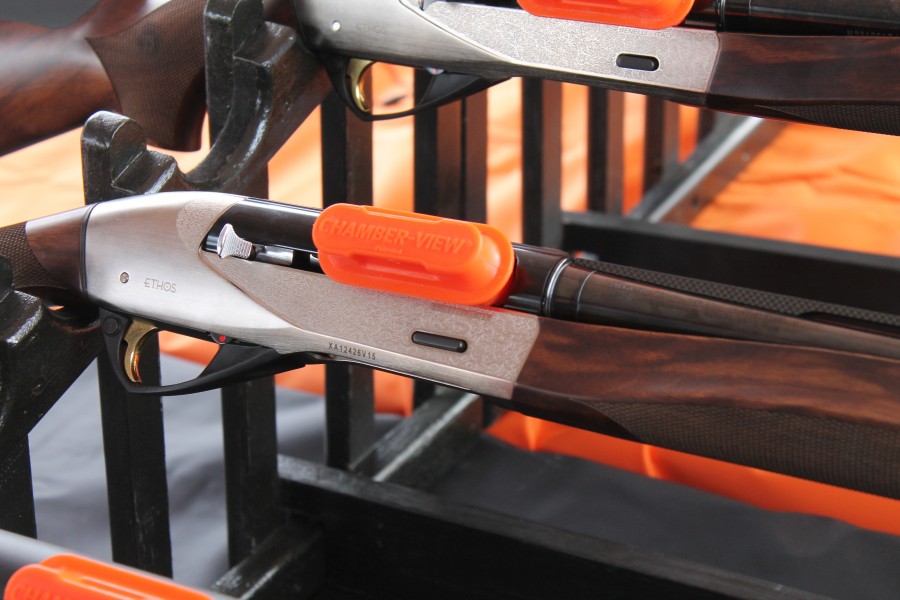
By far the coolest shotgun I saw under the Benelli tent was their new for 2016 Ethos sporting a three-inch 28 gauge chambering. While I spend most of my time in the field with heavy-hitting three or three-and-a-half inch twelve gauge guns, I’m attracted to the new for 2016 Ethos for two reasons. The first is the cool Barbour waxed cotton field jacket I’d have to wear whilst carring a $2200 shotgun out in the field . . .
The second is the fact that it’s a total pussycat to shoot. With 2-3/4″ loads, it was on par with some of the 9mm carbines I’ve shot. Where the excellent twelve gauge Ethos tips the scales at a hair under six and a half pounds, the 28 gauge version is slightly over five and a quarter. And boy can you feel the difference.

Shouldering the gun is second nature, and it swings beautifully thanks to the light weight, and excellent balance. The relative lack of recoil makes follow up shots a total breeze, but if my experience today is indicative, you’ll likely not need them as this gun flat out hits what you’re aiming for. I only ran 10 or so rounds through it, but there was a significant amount of dead clay pigeons on the ground when I was done.

For those whose first thought was, “3-inch 28 gauge? Madness!”, know that Benelli and Fiocchi have teamed up to ensure just such ammo available once this gun hits shelves. Our contacts at Benelli indicate this “magnum” 28 gauge will offer similar ballistics to your typical 20 gauge loads in a smaller, more nimble package. My main contact at Benelli has his eyes on some for some upcoming bird hunts, and I’ve asked if we can pretty, pretty please have one for some longer term testing. Watch this space.




A 3 inch 28 gauge? Why? No one is going to hunt ducks with steel shot with a 28. A 28 is an expert’s upland gun, and they’re supposed to be light, nimble and quick to mount.
This is a solution in search of a problem, IMO.
A 28 gauge just seems so ‘specialized’ to me. It’s a bit better than a .410 and a bit worse than a 20 gauge (ymmv).
I understand the “challenge” on a trap and skeet range. What I don’t understand is the application in the real world of hunting. My old Model 11 in 12 gauge will crank out however many rounds per day, kill the quarry, and leave my shoulder well in tact. I won’t risk losing game because of a “skilled” shot, any more than I would want to hunt mid-sized game with an AR/M poodle-popper. When I hunt, I hunt to kill, not to demonstrate my ‘prowess’ with a boutique caliber, vastly under powered for the animal, dependent on a “good shot”.
I’ll stick with a 12 ga. when hunting anything with wings. They deserve to have the best chance of being dispatched with the first shot, not hoping the follow-up will maybe finally kill them. Just me and all that.
You’d have to heft a 28 from the days of old. They were far lighter to carry afield for an entire day, and a great little dove or quail gun. The 28 gained popularity 100 years ago, when SxS’s were the norm, and pumps and semi-autos were still not the choice of upland hunters. A SxS or O/U in 28 is far lighter, snappier and faster-swinging than a 12 or even a 20. It isn’t about the challenge, it was about having a lighter, faster-swinging gun.
As for the load: A typical dove load in a 28 will be 3/4 oz of 7.5 or 8 shot. A typical load I’ll use in a 12 ga for dove will be 7/8ths oz of #8’s, ie, a AA super-light trap load. Not a huge difference in shot load. Dove loads in a 20 ga. will be 3/4 oz of #8’s as well. A heavy dove load in a 12 will be 1 1/8th oz of 7.5’s, which I find shreds the birds if they’re close in.
Fair enough. I have friends with some of the NLA (in the US anyway) chamberings 14, 18(!), 24, 32 and a couple I forget. Generally excellent (and expensive) craftsmanship, seldom seen these days. Most of my experience with them was/is in the midwest, and I’ve never really gotten to the point where I appreciated the difference. I’m aware there very much is one, but I just never developed an affinity I guess. Maybe it’s that I never hunt anything that flies smaller than a duck…
Egads, 1 1/8 out of a 28, I bet it does shred doves up close.
2 or 4 in magazine? Looks like it’s 2 but not sure
I can only imagine the frustration in trying to find 3″ ammo in 28 gage in the future……
This brings to mind a ‘want’ I’ve had for a while: A 16 gauge – ANY 16 gauge – with a 3″ or even a 3 1/4″ chamber.
The 20 and 12 gauges are fine, and with all the ammo available between the two of them do it all I suppose. But the one 16 gauge I ever shot (and old borrowed 870) just felt really … nice. I never went to it simply because ammo selection is too limited.
Now here Fiocchi & Benelli are saying ‘F@ck it – let’s jump start this sucker!’ For 28 gauge?! The 16 gauge has been lamented as the most effective ‘Forgotten Gauge’ for as long as I can remember, and yet they go to all that trouble for the 28 … It’s enough to make a grown man weep, I tell ya!
I have hunted grouse and all small game with 28 gauge Iver Johnson single shoot gun for many years. It’s a great shotgun.I use a 28 gauge for skeet with many other shooter’s there a great O/U shot gun. Looking forword to see this new shotgun in 3″.
The point of 3″ 28 gauge is to satisfy 28 gauge users, who are struggling to fit enough steel shot into the hull, to fill out 40 yard patterns. I know I am. I hope Ballistic Products Inc. starts working on 3″ TPS wads, towards that purpose.
I don’t agree, look at:
http://krets.jagareforbundet.se/hylte_unnaryd/files/2011/09/2004AlliantPowderSM.pdf
Friendly, Teresia
Comments are closed.